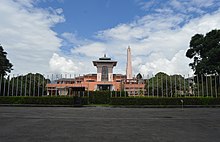Mass murder in the Nepalese royal family

The mass murder in the Nepalese royal family took place on June 1, 2001. Ten members of the royal family were shot dead, including the incumbent King Birendra .
Sequence of events
According to the official investigation report, a dispute broke out at a joint meal of the royal family in the Narayanhiti Palace in the capital Kathmandu . Crown Prince Dipendra then suddenly left the meeting, returned a short time later in battle uniform and shot around with an automatic weapon. Dipendra had previously drank two glasses of whiskey, smoked hashish and another drug, and telephoned his fiancée Devyani Rana. After the fact, Crown Prince Dipendra is said to have shot himself. The following died immediately in the massacre of the royal family:
- King Birendra
- Queen Aishwarya
- Prince Nirajan (the king's younger son)
- Princess Shruti (the king's daughter)
- Princess Shanti (a sister of the king)
- Princess Sharada (a sister of the king)
- Princess Jayanti (a cousin of the king)
- Kumar Khadga (Consort of Princess Sharada)
The Crown Prince Dipendra himself, Princess Komal (sister-in-law of King Birendra and wife of the Prince and later King Gyanendra), Princess Shova (a sister of the King), Kumar Gorakh (Princess Shruti's husband) and Ketaki Singh (cousin of King Birendra) suffered serious injuries. Prince Dhirendra, the youngest brother of King Birendra, died like Crown Prince Dipendra later from his serious injuries.
After the massacre of the Nepalese royal family, the State Council, which included all important politicians in the country and members appointed by the royal family, proclaimed Crown Prince Dipendra as the new king on June 2, 2001, despite the suspicion and serious injuries, and at the same time appointed his uncle Gyanendra as regent . King Dipendra, who had been in a coma since the massacre, died on June 4, 2001 in Kathmandu. After his death, the State Council appointed Dipendra's uncle Prince Gyanendra, who was absent at the time of the crime, as the new king. After the coronation, there were riots and protests against the new king, in which a protester was killed.
Possible triggers
It is speculated that a dispute over the Crown Prince Dipendra's will to marry led to his assassination attempt. Since the king and queen did not agree to a marriage between Dipendra and Devyani Rana, who comes from a rival family, the latter made the decision to kill his parents and himself. The Rana clan provided the Nepalese prime minister until the 1950s , a title that was formerly hereditary and surpassed the political and financial power of the royal family. Although eyewitnesses report that Dipendra had committed the act himself, there was speculation in the Nepalese public about a murder on behalf of Gyanendra, which should bring him into the position of heir to the throne. These conspiracy theories are also supported by the fact that the later King Gyanendra was not present that evening and the right-handed Dipendra was found with a gunshot wound to his left temple. His alleged suicide was not observed. The offer of a forensic investigation by Scotland Yard was not accepted.
The event of June 1, 2001 is commonly held responsible for the complete abolition of the monarchy in 2008, as trust in the royal family was shaken and the more popular King Birendra died.
Individual evidence
- ↑ BBC: Nepal mourns slain king , June 2, 2001, accessed November 3, 2018
- ↑ BBC: Five thousand at Indian wedding , February 23, 2007, accessed November 3, 2018
- ↑ Neue Osnabrücker Zeitung: Osnabrücker Paul Ivan Nagy writes book about regicide , June 2, 2018, accessed on November 3, 2018
- ↑ New York Times: A Witness To Massacre In Nepal Tells Gory Details , June 8, 2001, accessed November 3, 2018
- ↑ World: Nepal's King vacates the palace by limousine , June 11, 2008, accessed on November 3, 2018
